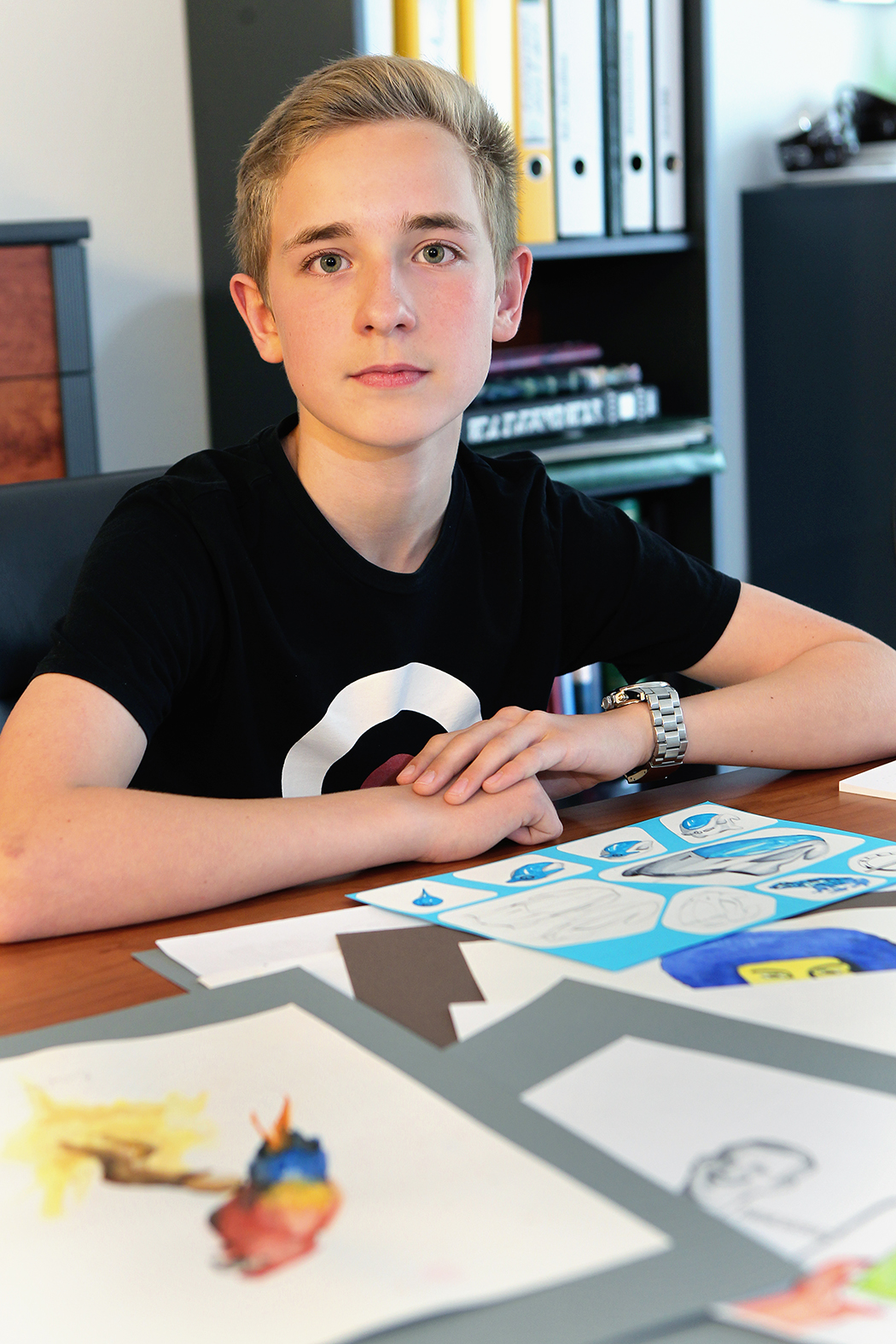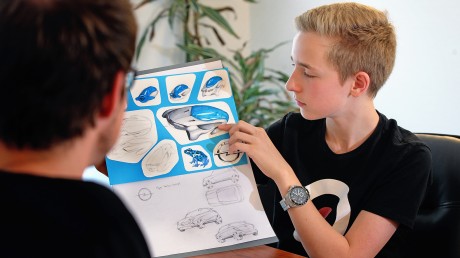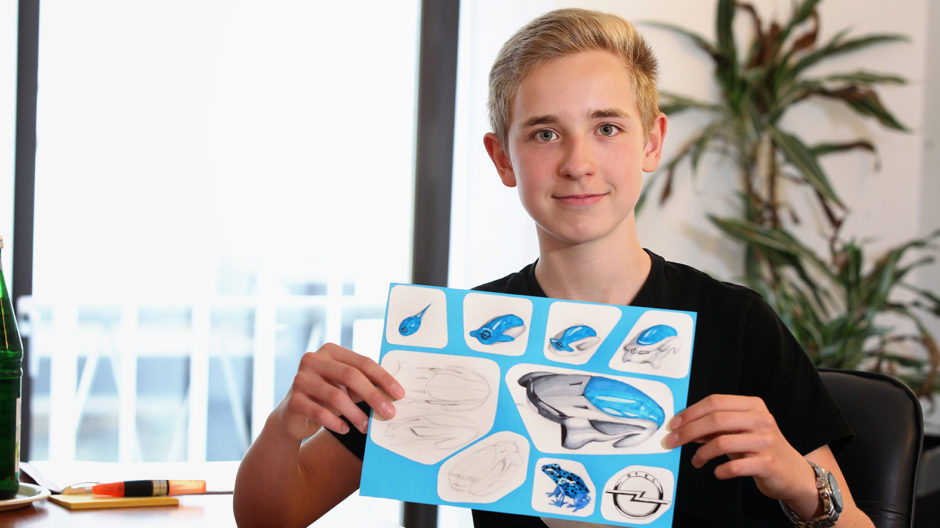- Kaulquappe mit Blitz – von Valentin Natschke. Der 14 Jahre alte Zeichner lässt sich bei seinen Design-Studien von der Natur inspirieren. Für den Entwurf zum Opel „Frog II“ nahm der Schüler eine Larve der Froschlurche, kurz Frösche genannt, als Ausgangspunkt. Die gewagten, doch eleganten Formen…
- …entwickelte Natschke Stück für Stück weiter – analog zum Wachstum der tierischen Vorlage. Der Frosch diente vor allem als Design-Vorlage und Namensgeber.
- Technisch hat die Studie mit dem klassischen „Laubfrosch“ aus dem Jahr 1924 oder der Konzeptstudie „Frogster“ (2001) wenig gemein. Auffälligste Innovation…
- …ist der Antrieb per Magnetschwebe-Technik. Deshalb hat der „Frog II“ keine Räder mehr. Der schnittige Opel der Zukunft gleitet in der Vorstellung von Valentin Natschke ganz ohne Fahrer ans Ziel.
- Die Ähnlichkeit mit dem blauen Pfeilgiftfrosch ist leicht zu erkennen.
- Diese Skizze diente Valentin Natschke als Grundlage für den „Frog II“.
- Ein Überblick: Die Arbeit des Nachwuchsdesigners.
- Eine weitere Idee mit Charme ist der Opel „Ventus“ (unten im Bild). Er soll mittels spezieller Lüftungsschlitze Fahrtwind durch eine Turbine leiten, um zusätzliche Energie zu gewinnen.

Valentin Natschke at his work desk.
A driver searches for his destination on a tablet, taps ‘Start,’ and the car gently whirs away. As the journey gets underway, he settles back on the couch for a movie with his friends, all while safely and quickly taking the car to its destination. Does anyone believe 14-year-old Valentin Natschke? Is this really the Opel of the future? The student from Fachbach near Koblenz is a talented artist and a fan of the lightning bolt brand. He has put pen to paper to draw detailed designs for his prototypes. He even has a name for the luxury blue driverless sedan with elegant, sporty curves. He’d call it the “Frog II”. He has sketched it from different angles exclusively for Opel Post. Judging from the style, you could easily mistake him for a professional designer.
Steering and wheels are obsolete
Natschke is convinced that the traditional car as we know it will eventually become obsolete. “We’ll definitely still have sports cars that you drive yourself, but getting from point A to point B will be an automatic process.” That’s why his Opel Frog only has a steering wheel only to be used in the event that navigation fails. This creates a lot of space in the interior, which is why Natschke swapped the traditional car seats for a U-shaped couch. For him, the car of the future is a kind of mobile living room. The windows double up as television screens and display for information like driving speed. The “Frog II” will be capable of reaching very high speeds, as it uses magnetic levitation technology, just without the rail tracks. That’s how the new model of the Opel classic gets by without any wheels.

The up-and-coming talent with two Opel Ideas: The upper drawings show Natschke’s “Frog II” study, the lower the award-winning “Ventus” design, a kind of SUV version of the ADAM.
Car studies garner praise from the jury
The work of the talented car enthusiast has attracted a lot of attention in the art world. He won the Alexandra-Lang Rhineland-Palatinate Youth Art Prize in April and presented an exhibition of his current sketches at the State Museum in Mainz. His “Ventus” Opel study, a kind of SUV version of the ADAM, was very well received by the jury, who noted that the student’s car sketches are strikingly different from those of his peers. Valentin Natschke has worked hard to get to where he is. “I don’t want to know how many cars I’ve drawn so far, but it probably reaches into the thousands.” Natschke has been attending a youth art group once a week for the past two years. It’s taught him basic techniques. His portfolio contains sketches of animals, still lifes, and abstract works.
Insignia and blue poison dart frog as inspiration
He feels differently about cars though. “Sometimes I just copy other things. But when it comes to cars, I only take the skeletal structure and design the rest the way I want.” He usually gets design ideas from the Internet, where he’s viewed hundreds of car designs. The Insignia and a blue poison dart frog model were the inspiration behind the Opel Frog II. The Ventus study, a symbiosis of ADAM and Mokka, gains additional energy from a turbine driven by the air stream.
It began with a Manta
The passion for cars inspired a legendary model a few years ago: “A car mechanics living near me drives a yellow Manta with a black hood. It’s awesome.” Valentin got fresh inspiration for his design studies when one of his neighbors recently got an Opel Adam as a rental and he enjoyed the opportunity to put together his own personal Adam. “People now want to use their car to show off who they are.” So what’s Valentin’s ultimate dream when it comes to buying a car? “It would be cool to be able to send in your own designs.” Even if it never comes to that, Valentin Natschke wants to be in the mix in the future. He has already decided that he wants to study automotive design.
Valentin Natschke from Fachbach near Koblenz is a talented amateur car designer and winner of the Alexandra-Lang Rhineland-Palatinate Youth Art Prize.
The student is inspired by what he sees on the streets and on the Internet, for example, the Opel Mokka or the ADAM.
The Opel “Frog II” study is a luxury driverless sedan that Natschke sketched exclusively for Opel Post. The car is powered using magnetic levitation technology. A magnet on the road and a magnet in the car mutually repel each other, creating the energy required to propel the vehicle forward.
A fingerprint scanner is used to open the hatch and the interior, which features a U-shaped couch. Drivers use a tablet to program the car, which then drives automatically. The steering wheel is only necessary in emergencies.
All of the windows in the futuristic car serve as touch-enabled monitors, either for watching television or displaying information such as current speed.








